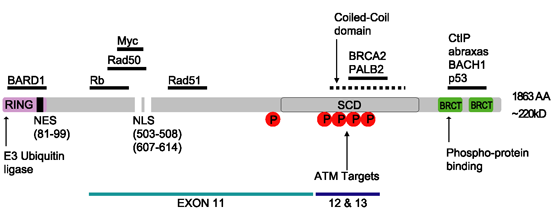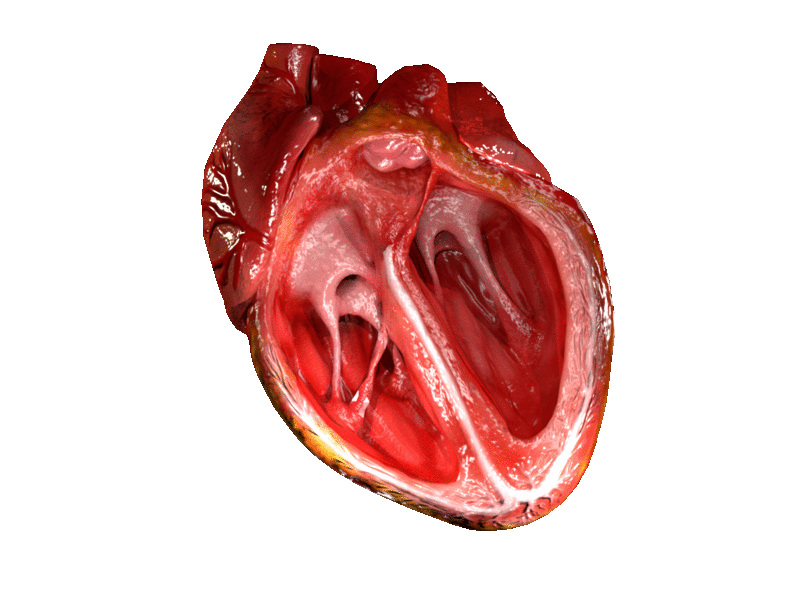|
TOPBP1
DNA topoisomerase 2-binding protein 1 (TOPBP1) is a scaffold protein that in humans is encoded by the ''TOPBP1'' gene. TOPBP1 was first identified as a protein binding partner of DNA TOP2B, topoisomerase-IIβ by a Two-hybrid screening, yeast 2-hybrid screen, giving it its name. TOPBP1 is involved in a variety of nuclear specific events. These include DNA repair, DNA damage repair, Eukaryotic DNA replication, DNA replication, transcriptional regulation, and Cell cycle checkpoint, cell cycle checkpoint activation. TOPBP1 primarily regulates the DNA damage repair response through its ability to activate the damage response kinase, Ataxia telangiectasia and Rad3 related, ataxia-telangiectasia mutated and RAD3-related (ATR). It also plays a critical role in DNA replication initiation and regulation of the cell cycle. Changes in TOPBP1 gene expression are associated with pulmonary hypertension, breast cancer, glioblastoma, Non-small-cell lung carcinoma, non-small cell lung cancer, and ... [...More Info...] [...Related Items...] OR: [Wikipedia] [Google] [Baidu] |
Ataxia Telangiectasia And Rad3 Related
Serine/threonine-protein kinase ATR, also known as ataxia telangiectasia and Rad3-related protein (ATR) or FRAP-related protein 1 (FRP1), is an enzyme that, in humans, is encoded by the ''ATR'' gene. It is a large kinase of about 301.66 kDa. ATR belongs to the phosphatidylinositol 3-kinase-related kinase protein family. ATR is activated in response to single strand breaks, and works with ATM to ensure genome integrity. Function ATR is a serine/threonine-specific protein kinase that is involved in sensing DNA damage and activating the DNA damage checkpoint, leading to cell cycle arrest in eukaryotes. ATR is activated in response to persistent single-stranded DNA, which is a common intermediate formed during DNA damage detection and repair. Single-stranded DNA occurs at stalled replication forks and as an intermediate in DNA repair pathways such as nucleotide excision repair and homologous recombination repair. ATR is activated during more persistent issues with DNA damage ... [...More Info...] [...Related Items...] OR: [Wikipedia] [Google] [Baidu] |
TOP2A
DNA topoisomerase IIα is a human enzyme encoded by the ''TOP2A'' gene. Topoisomerase IIα relieves topological DNA stress during transcription, condenses chromosomes, and separates chromatids. It catalyzes the transient breaking and rejoining of two strands of duplex DNA which allows the strands to pass through one another. Two forms of this enzyme exist as likely products of a gene duplication event. The gene encoding this form, alpha, is localized to chromosome 17 and the beta gene is localized to chromosome 3. The gene encoding this enzyme functions as the target for several chemotherapy agents and a variety of mutations in this gene have been associated with the development of drug resistance. Reduced activity of this enzyme may also play a role in ataxia-telangiectasia. Interactions TOP2A has been shown to interact with SMURF2, HDAC1, CDC5L, Small ubiquitin-related modifier 1, P53, and TOPBP1. In other species In ''Drosophila'' Hadlaczky et al 1988 found DNA topois ... [...More Info...] [...Related Items...] OR: [Wikipedia] [Google] [Baidu] |
MDC1
Mediator of DNA damage checkpoint protein 1 is a 2080 amino acid long protein that in humans is encoded by the ''MDC1'' gene located on the short arm (p) of chromosome 6. MDC1 protein is a regulator of the Intra-S phase and the G2/M cell cycle checkpoints and recruits repair proteins to the site of DNA damage. It is involved in determining cell survival fate in association with tumor suppressor protein p53. This protein also goes by the name Nuclear Factor with BRCT Domain 1 (NFBD1). Function Role in DNA damage response The ''MDC1'' gene encodes the MDC1 nuclear protein which is part of the DNA damage response (DDR) pathway, the mechanism through which eukaryotic cells respond to damaged DNA, specifically DNA double-strand breaks (DSB) that are caused by ionizing radiation or chemical clastogens. The DDR of mammalian cells is made up of kinases, and mediator/adaptors factors. In mammalian cells the DDR is a network of pathways made up of proteins that function as either ... [...More Info...] [...Related Items...] OR: [Wikipedia] [Google] [Baidu] |
Eukaryotic DNA Replication
Eukaryotic DNA replication is a conserved mechanism that restricts DNA replication to once per cell cycle. Eukaryotic DNA replication of chromosomal DNA is central for the duplication of a Cell (biology), cell and is necessary for the maintenance of the eukaryotic genome. DNA replication is the action of DNA polymerases synthesizing a DNA strand complementary to the original template strand. To synthesize DNA, the double-stranded DNA is unwound by DNA helicases ahead of polymerases, forming a replication fork containing two single-stranded templates. Replication processes permit copying a single DNA double helix into two DNA helices, which are divided into the daughter cells at mitosis. The major enzymatic functions carried out at the replication fork are well conserved from prokaryotes to eukaryotes, but the replication machinery in eukaryotic DNA replication is a much larger complex, coordinating many proteins at the site of replication, forming the replisome. The replisome is ... [...More Info...] [...Related Items...] OR: [Wikipedia] [Google] [Baidu] |
E2F1
Transcription factor E2F1 is a protein that in humans is encoded by the ''E2F1'' gene. Function The protein encoded by this gene is a member of the E2F family of transcription factors. The E2F family plays a crucial role in the control of cell cycle and action of tumor suppressor proteins and is also a target of the transforming proteins of small DNA tumor viruses. The E2F proteins contain several evolutionarily conserved domains found in most members of the family. These domains include a DNA binding domain, a dimerization domain which determines interaction with the differentiation regulated transcription factor proteins (DP), a transactivation domain enriched in acidic amino acids, and a tumor suppressor protein association domain which is embedded within the transactivation domain. This protein and another 2 members, E2F2 and E2F3, have an additional cyclin binding domain. This protein binds preferentially to retinoblastoma protein pRB in a cell-cycle dependent manner. I ... [...More Info...] [...Related Items...] OR: [Wikipedia] [Google] [Baidu] |
RAD9A
Cell cycle checkpoint control protein RAD9A is a protein that in humans is encoded by the ''RAD9A'' gene.''Rad9'' has been shown to induce G2 arrest in the cell cycle in response to DNA damage in yeast cells. ''Rad9'' was originally found in budding yeast cells but a human homolog has also been found and studies have suggested that the molecular mechanisms of the S and G2 checkpoints are conserved in eukaryotes. Thus, what is found in yeast cells are likely to be similar in human cells. Function This gene product is highly similar to S. pombe rad9, a cell cycle checkpoint protein required for cell cycle arrest and DNA damage repair in response to DNA damage. This protein is found to possess 3' to 5' exonuclease activity, which may contribute to its role in sensing and repairing DNA damage. It forms a checkpoint protein complex with Rad1 and Hus1. This is also known as the Rad9-Rad1-Hus1 or 9-1-1 complex. This complex is recruited by checkpoint protein Rad17 to the sites of DNA ... [...More Info...] [...Related Items...] OR: [Wikipedia] [Google] [Baidu] |
BRCA1
Breast cancer type 1 susceptibility protein is a protein that in humans is encoded by the ''BRCA1'' () gene. Orthologs are common in other vertebrate species, whereas invertebrate genomes may encode a more distantly related gene. ''BRCA1'' is a human tumor suppressor gene (also known as a caretaker gene) and is responsible for repairing DNA. ''BRCA1'' and ''BRCA2'' are unrelated proteins, but both are normally expressed in the cells of breast and other tissues, where they help repair damaged DNA, or destroy cells if DNA cannot be repaired. They are involved in the repair of chromosomal damage with an important role in the error-free repair of DNA double-strand breaks. If ''BRCA1'' or ''BRCA2'' itself is damaged by a BRCA mutation, damaged DNA is not repaired properly, and this increases the risk for breast cancer. ''BRCA1'' and ''BRCA2'' have been described as "breast cancer susceptibility genes" and "breast cancer susceptibility proteins". The predominant allele has a no ... [...More Info...] [...Related Items...] OR: [Wikipedia] [Google] [Baidu] |
BRCT Domain
BRCA1 C Terminus (BRCT) domain is a family of evolutionarily related proteins. It is named after the C-terminal domain of BRCA1, a DNA-repair protein that serves as a marker of breast cancer susceptibility. The BRCT domain is found predominantly in proteins involved in cell cycle checkpoint functions responsive to DNA damage, for example as found in the breast cancer DNA-repair protein BRCA1. The domain is an approximately 100 amino acid tandem repeat, which appears to act as a phospho-protein binding domain. Examples Human proteins containing this domain include: * BARD1; BRCA1 * CTDP1; TDT or DNTT * ECT2 * LIG4 * MCPH1; MDC1 * NBN * PARP1; PARP4; PAXIP1; PES1 * REV1; RFC1; TOPBP1 DNA topoisomerase 2-binding protein 1 (TOPBP1) is a scaffold protein that in humans is encoded by the ''TOPBP1'' gene. TOPBP1 was first identified as a protein binding partner of DNA TOP2B, topoisomerase-IIβ by a Two-hybrid screening, yeast 2- ...; TP53BP1; XRCC1 References ... [...More Info...] [...Related Items...] OR: [Wikipedia] [Google] [Baidu] |
Pulmonary Hypertension
Pulmonary hypertension (PH or PHTN) is a condition of increased blood pressure in the pulmonary artery, arteries of the lungs. Symptoms include dypsnea, shortness of breath, Syncope (medicine), fainting, tiredness, chest pain, pedal edema, swelling of the legs, and a fast heartbeat. The condition may make it difficult to exercise. Onset is typically gradual. According to the definition at the 6th World Symposium of Pulmonary Hypertension in 2018, a patient is deemed to have pulmonary hypertension if the pulmonary mean arterial pressure is greater than 20mmHg at rest, revised down from a purely arbitrary 25mmHg, and pulmonary vascular resistance (PVR) greater than 3 Wood units. The cause is often unknown. Risk factors include a family history, prior pulmonary embolism (blood clots in the lungs), HIV/AIDS, sickle cell disease, cocaine use, chronic obstructive pulmonary disease, sleep apnea, living at high altitudes, and problems with the mitral valve. The underlying mechanism typ ... [...More Info...] [...Related Items...] OR: [Wikipedia] [Google] [Baidu] |
C-terminus
The C-terminus (also known as the carboxyl-terminus, carboxy-terminus, C-terminal tail, carboxy tail, C-terminal end, or COOH-terminus) is the end of an amino acid chain (protein Proteins are large biomolecules and macromolecules that comprise one or more long chains of amino acid residue (biochemistry), residues. Proteins perform a vast array of functions within organisms, including Enzyme catalysis, catalysing metab ... or polypeptide), terminated by a free carboxyl group (-COOH). When the protein is translated from messenger RNA, it is created from N-terminus to C-terminus. The convention for writing peptide sequences is to put the C-terminal end on the right and write the sequence from N- to C-terminus. Chemistry Each amino acid has a carboxyl group and an amine group. Amino acids link to one another to form a chain by a dehydration reaction which joins the amine group of one amino acid to the carboxyl group of the next. Thus polypeptide chains have an end with an ... [...More Info...] [...Related Items...] OR: [Wikipedia] [Google] [Baidu] |
PLK1
Serine/threonine-protein kinase PLK1, also known as polo-like kinase 1 (PLK-1) or serine/threonine-protein kinase 13 (STPK13), is an enzyme that in humans is encoded by the ''PLK1'' ( polo-like kinase 1) gene. Structure PLK1 consists of 603 amino acids and is 66kDa. In addition to the N-terminus kinase domain, there are two conserved polo-box regions of 30 amino acids at the C-terminus. Kinase activity is regulated at least in part, by the polo-boxes that are functionally important for both auto-inhibition and subcellular localization. Localization During interphase, PLK1 localizes to centrosomes. In early mitosis, it associates with mitotic spindle poles. A recombinant GFP-PLK1 protein localizes to centromere/kinetochore region, suggesting a possible role for chromosome separation. Cell cycle regulation Plk1 is an early trigger for G2/M transition. Plk1 supports the functional maturation of the centrosome in late G2/early prophase and establishment of the bipolar spi ... [...More Info...] [...Related Items...] OR: [Wikipedia] [Google] [Baidu] |



